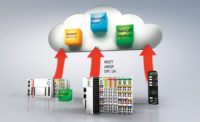Automation
There Is No One-Size-Fits-All IIoT Strategy
With or without the cloud, scalable IIoT technologies solve common problems, such as inefficient compressed air systems.


The broad analytics toolkit in Beckhoff’s TwinCAT automation software features one-click dashboard creation, which is customizable and responds to screen sizes from desktop monitors to smartphones.
Photo: Beckhoff Automation


In packaging plants across the world, compressed air systems create significant energy waste. Pinhole leaks in air lines, sticky valves and other inefficiencies cost huge consumer packaged goods (CPG) manufactures and small contract packagers alike substantial amounts of money. These also hinder corporate green efforts for responsible energy usage. A key opportunity to solve compressed air issues and boost overall equipment effectiveness (OEE) is by thoughtfully implementing Industrial Internet of Things (IIoT) strategies with scalable PC-based automation technologies.
IIoT promises highly connected machines that improve efficiency and decrease production costs, which is intriguing for even the most traditional plant managers. However, most conversations about implementing IIoT strategies are little more than talk. Beneath the buzzwords and hype, the path forward remains murky — clouded by many questions and a lack of consensus. What is IIoT capable of today? What does it actually mean from a practical standpoint? How can it be implemented painlessly and with a fast ROI? Where is the best place to start?
The truth is, there is no one-size-fits-all IIoT strategy. Companies need to evaluate the business case, scope and goals behind any IIoT implementation. The results of this evaluation will drive the system architecture decisions. However, that doesn’t mean it has to be a huge, expensive project that will take years to generate a minimal ROI. By understanding IIoT strategies, engineering and management teams can harness new solutions for all systems across the plant floor, including compressed air. Implemented correctly, the payback could take mere weeks instead of years.
What can IIoT really do?
The capabilities of IIoT technologies are vast. Some functions possible with a scalable technology platform include:
- remote maintenance for machines located across the globe;
- remote, software-based changeovers for different packaging or product quantities;
- measurement of performance, uptime and downtime for machines and plants;
- throughput optimization via advanced analytics and machine learning algorithms;
- automated alerts via apps, email or text message to maintenance personnel, pinpointing specific machine and/or device malfunctions;
- enablement of virtual and augmented reality for more efficient remote support;
- track and trace of the supply chain, package barcodes, lot numbers and other important product data; and
- implementation of Industry 4.0 concepts, i.e. local mass production down to lot size 1.
IIoT strategies can reduce downtime through faster troubleshooting, and prevent similar problems in the future by using analytics dashboards to schedule maintenance. One real-world example of this is a recent project by Macon, Georgia-based iZ Systems, which saved a nearby Pactiv packaging facility $250,000 annually through compressed air system upgrades. With a foundation of scalable IIoT technologies and PC-based automation from Beckhoff, iZ Systems is able to continue monitoring and maintaining the system, as well as providing key performance indicators (KPIs) to the packaging company to validate the ongoing cost savings.
Not only will the packaging operation run more efficiently with higher availability, but it also will keep pace with consumer demands for increased customization and seasonal products. In some cases, this requires hardware or software adjustments, but these do not need to be expensive. Many times, machines and devices in the field are already generating valuable data, and they just need a targeted IIoT strategy that puts the data into action.
What actually is IIoT?
Dating to early Internet of Things (IoT) implementations — a Carnegie Mellon University vending machine retrofitted with a sensor and communicating over ARPANET in 1970 is often recognized as the first — the idea has remained relatively consistent. IoT simply involves connecting machines and components via a telecommunications infrastructure back to centralized computers with the ability to manipulate and monitor those machines remotely. Now, in the age of cloud computing and big data, the use of IoT for manufacturing is conflated with sending all data to a third-party cloud. As a result, IT and OT departments at companies have fought about how to gather, store and leverage information.
IIoT can certainly include a cloud-connected strategy, with real-time machine learning and analytics tools to optimize OEE. This strategy is a good fit for large, multi-site operations and could be beneficial for smaller packaging machine OEMs and CPG manufacturers, too. However, IIoT could also include aggregating data at the enterprise level, sending compressed binary files for review in analytics software or performing analytics on the machine controller during production.
Sometimes engineering and plant management don’t want to connect machines to the cloud for various reasons. Some don’t even want to connect machines to horizontal machine-to-machine (M2M) networks, leaving them true islands of automation. While this is often due to resistance to change, there can be valid security reasons as well. But vendors shouldn’t leave engineers stranded in these instances, and should offer solutions that provide IIoT advantages at any level.
Choose the right platform
IIoT strategies are not one-size-fits-all, so companies should look for a platform that accommodates significant customization. PC-based automation offers a universal platform for both machine control logic and effective use of all connected assets. The programming environment in Beckhoff’s TwinCAT 3 automation software, for example, is fully integrated into Microsoft Visual Studio®. This allows controls engineers to build IIoT projects in programming languages they are already familiar with, so companies don’t need to hire outside programmers or purchase expensive third-party software. TwinCAT 3 also supports the use of numerous computer science programming languages in the same projects if desired.
Platforms should support common IIoT project requirements with advanced analytics packages. TwinCAT, for example, now offers one-click dashboard creation for faster viewing of OEE information without starting from scratch on a complex HMI program. In addition, communication options include the most current encrypted cloud communication protocols, such as OPC UA, AMQP and MQTT. TwinCAT also integrates with Microsoft Azure, Amazon Web Services (AWS) and other cloud services. A built-in digital oscilloscope provides easier viewing of real-time data, and machine learning can make changes on the fly to automate production improvements without operator intervention. Unlike with traditional PLCs, this functionality can occur directly on the PC-based controller.
Industrial PC (IPC) hardware for IIoT applications can connect directly to the cloud — with or without the addition of an auxiliary gateway, depending on plant requirements. The IPC could serve as an edge computing device to process data and make decisions in real time before sending relevant data to the cloud for further analysis. For islands of automation, IPCs can still run advanced analytics or machine learning on board, and then maintenance staff can export and analyze data intermittently. The range of Beckhoff IPCs is well-suited to these tasks, with devices officially certified for both AWS and Azure. However, a smaller application could be as simple as a DIN rail-mounted IoT coupler that integrates into an existing EtherCAT I/O segment.
Start small and grow from there
For many small packaging operations or machine builder OEMs, it helps to start small. An IIoT project doesn’t have to be a multi-million-dollar plant upgrade or a trip into the Matrix. For example, in the case of monitoring compressed air, it could be adding one or more air sensors that communicate to the PC-based machine controller or gateway device. This would allow a company to send alarms to maintenance, create useful dashboards to monitor performance and analyze data for performance enhancements. These are all possible without giant capital investments.
Wherever you plan to start, make sure your technology platform offers scalability for the future. After all, IIoT may seem like a buzzword now, but the technology will only continue to grow.
Beckhoff Automation is a provider of advanced, open automation products for high performance machines. The company’s product range includes industrial PCs, distributed I/O, automation software, IoT solutions, servo drives, servomotors and linear motion solutions. beckhoff.com/Industrie40
Looking for a reprint of this article?
From high-res PDFs to custom plaques, order your copy today!








